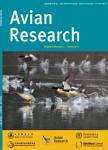Habitat selection by nestbox-breeding birds and Roe Deer are incongruent within a heterogeneous woodland landscape
Habitat selection by nestbox-breeding birds and Roe Deer are incongruent within a heterogeneous woodland landscape作者机构:WartonCarnforthLancashireLA59RAUK Field Research Station at Fort MissoulaDivision of Biological SciencesUniversity of MontanaMissoulaMT59812USA
出 版 物:《Avian Research》 (鸟类学研究(英文版))
年 卷 期:2022年第13卷第1期
页 面:43-48页
核心收录:
主 题:Capreolus capreolus Cyanistes caeruleus Ficedula hypoleuca Habitat use Nestboxes Nest site selection Parus major Woodlands
摘 要:Conserving species relies upon acquiring an understanding of their use of habitat,yet our understanding of the use of habitat by co-existing species of different guilds at microgeographic scales remains *** particular,the use of habitat by woodland species is of conservation concern because of widespread declines in woodland *** bird declines have been ascribed,in part,to high deer densities because their browsing reduces the availability of nesting sites and *** quantify the microgeographic use of habitat by Roe Deer(Capreolus capreolus)and of Great Tits(Parus major),Blue Tits(Cyanistes caeruleus)and Pied Flycatchers(Ficedula hypoleuca)in a heterogenous woodland *** examined the use of habitat at microgeographic scales by the deer and the three bird species in relation to whether the local habitat was flat or wet or had a path,fence or wall within a 25-m radius of 206 randomly selected *** first examined if the occupancy rates of nestboxes in those locations were correlated with the number of Roe Deer lays and second,examined if the use of habitat by the Roe Deer and the bird species were associated with each of the habitat features that we *** begin by showing that the use of habitat by Roe Deer is incongruent with the use of habitat by Great Tits,Blue Tits and Pied Flycatchers during the breeding ***,whilst all three bird species showed no,or weak,habitat preferences,the Roe Deer preferred daytime lay sites that were in flat areas of wet woodland close to paths,whilst there were no significant effects of the presence of fences and *** findings show that the Roe Deer and the three bird species differ in the use of habitat within a heterogenous woodland landscape,meaning that their use of habitat did not overlap at microgeographic ***,the deer showed preferences for flat areas of wet woodland,whilst none of the bird species exhibited such preferences,and we discuss the implications o



